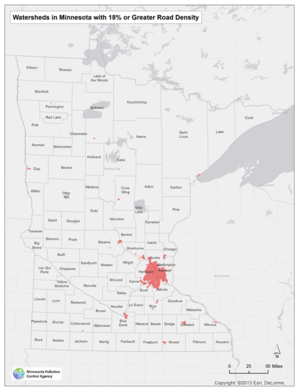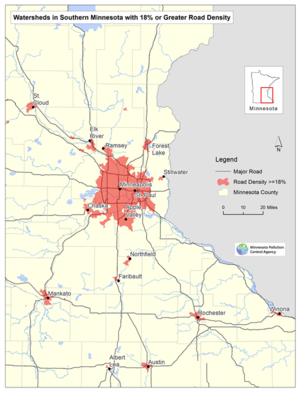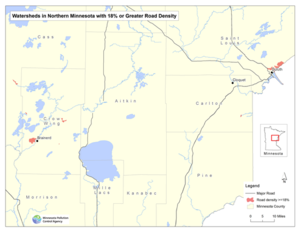
TCMA Chloride Management Plan - Prioritizing and Implementing Restoration and Protection
Contents
Prioritizing and Implementing Restoration and Protection
Reducing chloride at the source is needed throughout the entire TCMA, not only to restore already impacted waters but also to protect all water resources. There are multiple sources to consider, a variety of options to reduce chloride, and a large geographical area to address. This section is intended to provide guidance, resources, and information to assist in making the important decisions of the what, how and when for managing chloride. The available data indicates that surface waters and groundwater that exceed the state’s chloride standards, as well as many lakes and streams that are considered to be at high risk for chloride impairment. Many lakes, streams, and wetlands have minimal or no data available, especially during critical times of the year, which makes it difficult to determine the current chloride status. Reductions in chloride loads not only benefit surface and groundwater quality, but may also reduce damage to infrastructure and vehicles due to corrosion, and reduce impacts to vegetation along roadways. Finally, improved winter maintenance practices that reduce salt usage also result in direct cost-savings to winter maintenance organizations and private applicators. Without making efforts to reduce chloride loads, the trend of increasing chloride concentrations in lakes, wetlands, streams, and groundwater is expected to continue and the cost-savings related to improved winter maintenance practices will be lost. Treating waters already contaminated by chloride through RO or distillation is impractical and cost-prohibitive.
Performance-Based Approach for Reducing Chloride
Deicing salt is currently the most common and preferred method for meeting the public’s winter travel expectations. There is currently not an environmentally safe and cost-effective alternative that is effective at melting ice. Therefore, the continued use of salt as the predominant deicing agent for public safety in the TCMA is expected. Setting a specific chloride load reduction target for each individual winter maintenance chloride source is challenging, as is measuring actual chloride loads entering our surface and groundwater from deicing salt and other nonpoint sources in the TCMA. Therefore, priority should be put on improving winter maintenance practices to use only a minimal amount of salt, also referred to as Smart Salting, across the entire TCMA. With these considerations in mind, the implementation approach for achieving the TMDLs and protecting all waters in the TCMA is to focus on performance of improved winter maintenance practices as well as continuing to monitor trends in local waterbodies.
A standard approach to TMDL implementation is to translate the wasteload allocation (WLA) component of the TMDL directly to a numeric permit limit, which is typical for permitted facilities with monitoring requirements. In the case of urban stormwater regulated through a Municipal Separate Storm Sewer System (MS4) Permit, the WLA may be presented in the form of a percent reduction from a baseline condition. The specified percent reduction is then included in the MS4 Permit. With a performance-based approach, the numeric WLA is translated to a performance criterion. This can include the development and implementation of winter maintenance plan which identifies a desired level of the BMP implementation and a schedule for achieving specific implementation activities. Progress made towards those goals are documented and reported, along with annual estimates of salt usage and reductions achieved through BMPs implemented.
In cases where it is not feasible to calculate a numeric effluent limit, federal regulations allow for the use of the BMPs as effluent limits (40 CFR § 122.44(k)). Such a performance-based or BMP approach to compliance with WLAs is being taken by states to address the Chesapeake Bay TMDL for nutrients. The TMDL is being implemented through state Implementation Plans. Some states are taking a performance-based approach to addressing urban stormwater sources, requiring minimum levels of the BMP implementation rather than requiring specific levels of pollutant load reductions.
A performance-based approach will be tracked through documentation of existing winter maintenance practices, goals for implementing improved practices including schedules, and reporting on progress made. Entities may choose to use the Winter Maintenance Assessment tool (WMAt), which is a winter maintenance BMP tracking tool, to assess and document practices and set goals, or another approach of their choice. Entities should track progress and document efforts, including, to the extent possible, estimates of reduced salt usage as a result of improved practices. Entities that have achieved their goals for winter maintenance will have documented their practices in a winter maintenance plan. Entities that have already made significant progress in winter maintenance activities will be able to demonstrate this through their documentation of existing practices. This plan should be reviewed annually and evaluated against the latest knowledge and technologies available for winter maintenance.
The performance-based approach doesn’t focus on specific numbers to meet, but rather on making progress through the use of BMPs. Progress is measured by degree of implementation and trends in ambient monitoring. In a traditional approach with numeric targets, progress would be measured by accounting for salt applied and comparing to the targets. The performance-based approach is intended to allow for flexibility in implementation and recognize the complexities involved with winter maintenance. Because the performance-based approach does not provide a specific numeric target, a limitation of the approach is that it is not definitive on when enough progress has been made. This can only be determined by continued ambient monitoring that demonstrates compliance with water quality standards.
Prioritization and Critical Areas
This plan has been developed for many different audiences. Organizations interested in reducing the amount of salt in waters should start with an effort to fully understand the problem and determine what role the organization plays in contributing, preventing, or remediating the growing trend of increased chloride in surface and groundwater.
Prioritization of efforts to reduce chloride may be based on current water quality conditions. Waters found to exceed the state standard and their contributing watersheds should be given top priority for chloride reduction efforts. Many waters are considered to be high risk, but do not exceed the standard at this time. These areas may be given second priority unless there are no known chloride impairments in the watershed, and then the high risk waters could be given highest priority.
Prioritization of reduction efforts may also be based on the relative size and impact of the source of chloride, such as prioritizing winter maintenance activities in areas with a high density of impervious surfaces, or putting emphasis on residential water softeners for those watersheds where wastewater treatment facilities are identified as a major contributor of chloride. There may also be other ways that are more appropriate for each organization to determine where to prioritize reduction efforts.
Critical areas have been identified where chloride reduction efforts are necessary to achieve water quality goals. Two strategies have been used based on the source of chloride to identify critical watershed. The first strategy identifies watersheds with road densities of 18% or greater to identify watershed where chloride concentrations are typically above water quality standards. Figure 31 depicts the critical watersheds statewide; Figure 32 highlights the critical watersheds in southern Minnesota; and Figure 33 shows the critical watershed in the norther part of Minnesota. An interactive map showing these critical areas is available on the MPCA Road Salt & Water Quality website. The second strategy used to identify critical areas for chloride reduction focuses on areas with drinking water supply wells with hard and very hard water. Figure 10 identifies areas across the state where the drinking water supply is considered hard or very hard therefore requiring softening treatment. Through these two strategies critical areas have been identified across the state where chloride loadings are to be expected high and therefore implementation efforts to reduce chloride should be focused. For the protection of surface and ground waters implementation is encouraged statewide.
Implementation Strategies
This section provides the overall framework for the implementation strategies that are necessary to protect and restore our water resources. These high-level strategies are intended for both protection and restoration and are described by audience. The next section will provide more detailed implementation activities for the various sources of chloride. The over-arching implementation strategy is a performance-based approach. This approach allows stakeholders and regulators flexibility in the type of BMPs and the timing of implementation, and allows individuals an opportunity to develop chloride management strategies that are practical for their individual situation. Success under the performance-based approach will be measured in terms of the BMPs implemented.
A tool called the WMAt has been developed by the MPCA and is available for use by winter maintenance professionals across the state. The WMAt can be used voluntarily to understand current practices, identify areas of improvement, and track progress. While optional, everyone involved in winter maintenance is highly encouraged to use the WMAt. The tool is intended to streamline and simplify implementation goals and strategies. The tool can also be used to compare practices with other entities and learn from each other in order to achieve the greatest chloride reductions while providing a high level of service. Utilization of this planning tool will allow the user to track their progress over time and show the results of their efforts. The tool can serve as both a reporting mechanism to understand the current practices and as a planning tool to understand future practices. The planning side of the tool will help understand the challenges and costs associated with improved practices.
The overall performance-based implementation strategy for the primary audiences and a suggested timeframe is presented in the Performance-Based Chloride Reduction Strategies table with descriptive text following the figure. Secondary audiences are described at the end of this section and are not presented in a table.
Performance-Based Chloride Reduction Strategies
Link to this table
| Audience | years 1-2 | years 1-2 years 3-5 | years 6-10 | Beyond year 10 |
|---|---|---|---|---|
| Winter Maintenance Leadership (state, county, city, schools, private): those not involved in day to day operations of maintenance crew. |
|
|
|
|
| Winter Maintenance Professionals (state, county, city, schools, private): plow drivers, mechanics, supervisors of crew. |
|
|
|
|
| WMOs/WDs, Environmental Organizations and Institutions, and Educators |
|
|
|
|
| Municipalities |
|
|
|
|
| Wastewater Treatment Plants and Industrial Dischargers |
|
|
|
|
| Water Treatment Facilities (water supply) |
|
|
|
|
| Citizens |
|
|
|
|
| MPCA |
|
|
|
|
| Policy Makers (city, county, state, other) |
|
|
|
|
Winter Maintenance Leadership (State, County, City, Schools & Private)
Winter maintenance leadership is the group responsible for hands-on efforts and operation management. This group includes the individuals in charge of the shop facilities, selling winter maintenance services, determining the type of pavement overlays, or organizing the “getting ready for winter” refresher training. This group does not include the plow drivers or their direct supervisors.
Winter maintenance leadership is a very diverse group that plays a variety of roles across many organizations. Their influence is significant and they have great potential to positively impact reductions in salt use. This group can advocate for change by understanding the economic benefits of salt reduction, including the direct cost savings as a result of using less salt.
Table 9 presents example activities and timelines for winter maintenance leadership to consider. Throughout implementation, goals and practices should be reviewed, assessed, and adaptively updated to reduce the use of chloride. Examples presented in this section include specific possible actions. However, these actions are intended to be examples and are not meant to put emphasis on the specific actions. Each entity will need to assess the most relevant and cost-effective actions to take in their situation to reduce salt loadings.
Examples of Implementation Strategies for Winter Maintenance Leadership


